

Untitled Document - CODAP. Unit 1: Introduction to Modeling Dynamic Systems. Kirsten Menking (Vassar College), Louisa Bradtmiller (Macalester College), and David Bice (Penn State) This material was developed and reviewed through the InTeGrate curricular materials development process.
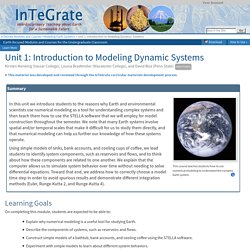
This rigorous, structured process includes: team-based development to ensure materials are appropriate across multiple educational settings. multiple iterative reviews and feedback cycles through the course of material development with input to the authoring team from both project editors and an external assessment team. real in-class testing of materials in at least 3 institutions with external review of student assessment data. multiple reviews to ensure the materials meet the InTeGrate materials rubric which codifies best practices in curricular development, student assessment and pedagogic techniques. review by external experts for accuracy of the science content.
This page first made public: Sep 15, 2017 Summary Learning Goals. Choosing a College Roommate: How Multi-Criteria Decision Modeling Can Help. Concord Consortium. Modeling is essential in the pursuit of scientific knowledge and, as such, is a central practice used across the science disciplines.
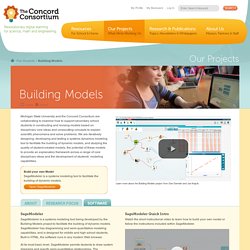
Scientists develop, revise and use models to predict and explain phenomena by expressing relationships between variables that provide a predictive or causal account of the phenomena. K-5 Science. Mathematical Modeling - Building Models from Data and Scientific Principles - MATLAB & Simulink. When you have physical insight, you can create models from first principles using analytic or symbolic approaches.
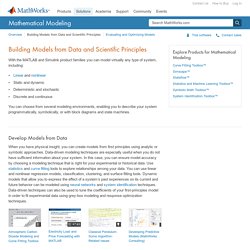
Data-driven modeling techniques are especially useful when you do not have sufficient information about your system. In this case, you can ensure model accuracy by choosing a modeling technique that is right for your experimental or historical data. Use statistics and curve fitting tools to explore relationships among your data. You can use linear and nonlinear regression models, classification, clustering, and surface fitting tools. Dynamic models that allow you to express the effect of a system’s past experiences on its current and future behavior can be modeled using neural networks and system identification techniques.
How to Make a Mathematical Model: 9 Steps. Steps Part 1 Preparing to Make a Mathematical Model <img alt="Image titled Make a Mathematical Model Step 1" src=" width="728" height="546" class="whcdn" onload="WH.performance.clearMarks('image1_rendered'); WH.performance.mark('image1_rendered');">1Determine what you want to know.

What is the objective of creating a model? Make a list of the data you want to find by using the model. Ecopath with Ecosim – Ecopath with Ecosim food web modeling approach. Educators - FlexSim Simulation Software. Investigation Station: Science Laboratory - Software - Model It. The Arena Advantage for Students. Since Arena Simulation Software is the most used Discrete Event Simulation Software in the world, students who have Arena experience possess a valuable skill sought after by many companies.
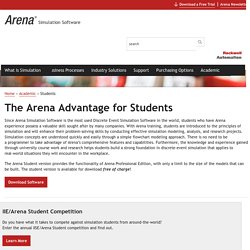
With Arena training, students are introduced to the principles of simulation and will enhance their problem-solving skills by conducting effective simulation modeling, analysis, and research projects. Simulation concepts are understood quickly and easily through a simple flowchart modeling approach. There is no need to be a programmer to take advantage of Arena’s comprehensive features and capabilities. Furthermore, the knowledge and experience gained through university course work and research helps students build a strong foundation in discrete-event simulation that applies to real-world situations they will encounter in the workplace. The Arena Student version provides the functionality of Arena Professional Edition, with only a limit to the size of the models that can be built.
Download Software. What is Modeling - Modeling Instruction in Michigan. Insight Maker User Forum. To everybody!
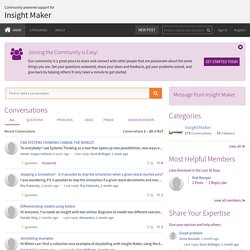
I see Systems Thinking as a tool that opens up new possiblilities, new ways of seeing things, new ways of dealing with old... stopping a simulation? - Is it possible to stop the simulation when a given stock reaches zero? I was wondering if it is possible to stop the simulation if a given stock decrements and reaches zero? Differentiating models using folders Hi everyone, I've made an insight with two similar diagrams to model two different outcomes. Storytelling examples. Insight Maker. Desmos Classroom Activities. In this activity, students model a situation with a quadratic function (but don’t tell them that at the outset!).
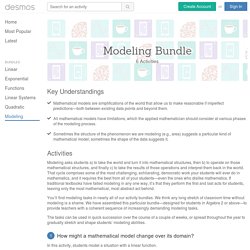
Penny Circle provides students with another opportunity to work through a common progression you’ll see in our modeling activities: (1) Make a prediction, (2) Collect data, (3) Build a model, and (4) Use the model. A common feature of modeling problems that we’re not thrilled about is that they often end as soon as students have built their model. So when students ask, “Why did we build this?” The response is sometimes little more than, “Because I said so.” In contrast, we believe models are built in order to be used. A noteworthy feature of this activity is that students must choose which function type ( linear, quadratic, or exponential) they’d like to use to build their model, and then reflect on whether (and if so, why) their model provides a nice fit for the data they and their classmates have collected.
AoCMM - Math Modeling Articles. Practices - Modeling. STEM Academy: EAGLE software now available free... Last month (June 2016), Autodesk officially acquired Cadsoft Computer GmbH from Premier Farnell, giving them ownership of the popular EAGLE PCB design software.
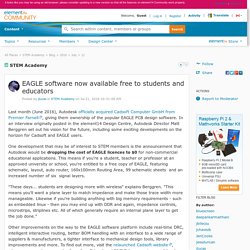
In an interview originally posted in the element14 Design Centre, Autodesk Director Matt Berggren set out his vision for the future, including some exciting developments on the horizon for Cadsoft and EAGLE users. One development that may be of interest to STEM members is the announcement that Autodesk would be dropping the cost of EAGLE licences to $0 for non-commercial educational applications.
This means if you're a student, teacher or professor at an approved university or school, you're entitled to a free copy of EAGLE, featuring schematic, layout, auto router, 160x100mm Routing Area, 99 schematic sheets and an increased number of six signal layers. Teaching with Computer Models. This set of web pages is a synthesis of materials produced by Louisa Bradtmiller, Deborah Gross, Kirsten Menking, and Cindy Shellito at the 2010 workshop on Developing Student Understanding on Complex Systems in the Geosciences.
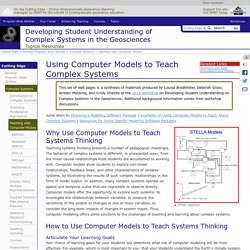
Additional background information comes from workshop discussions.